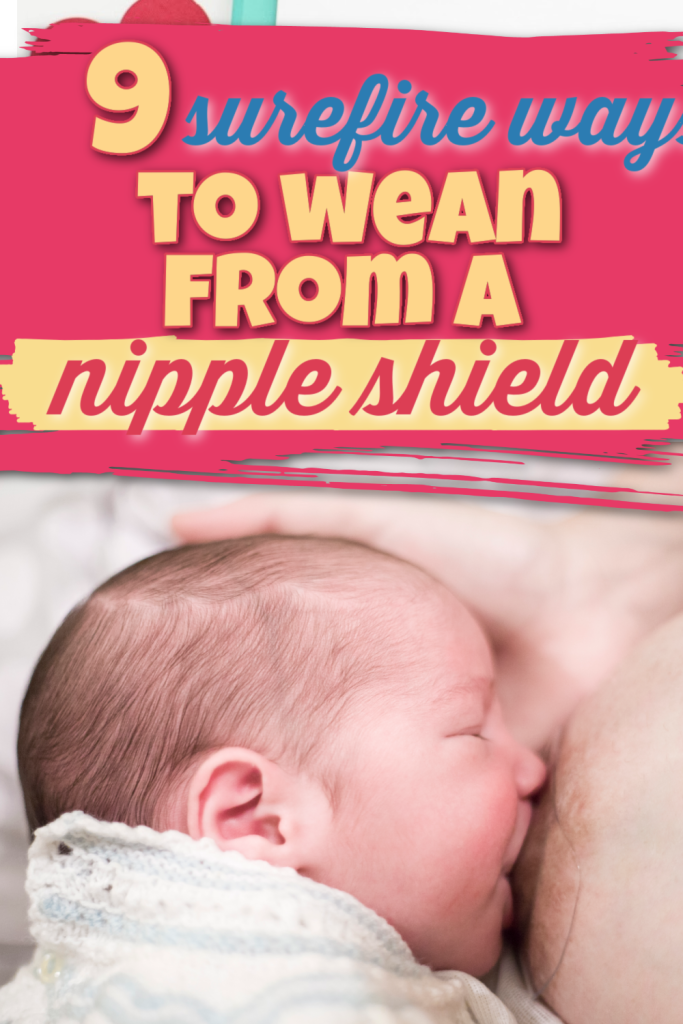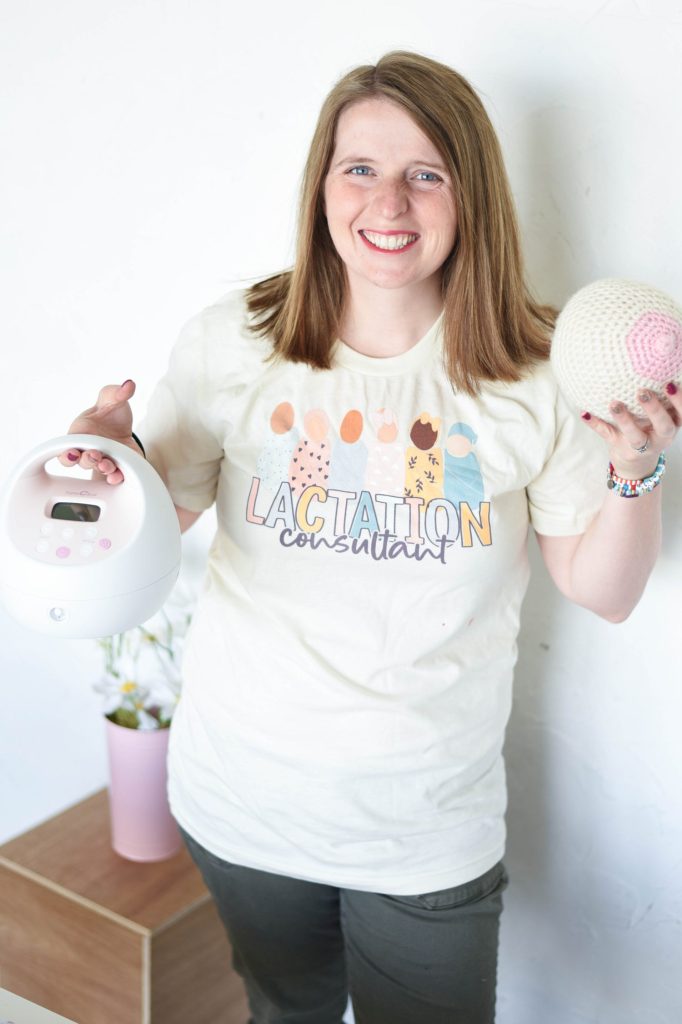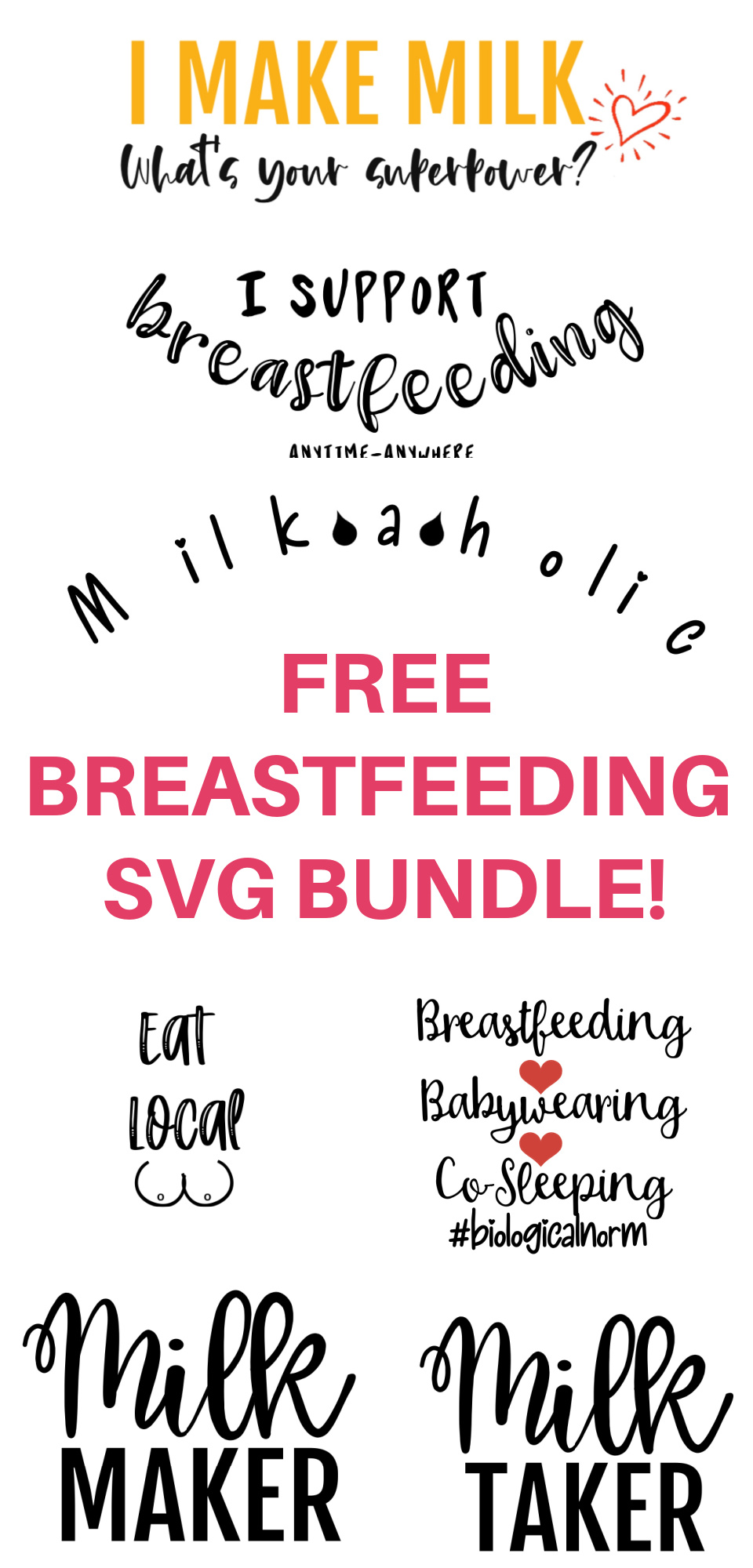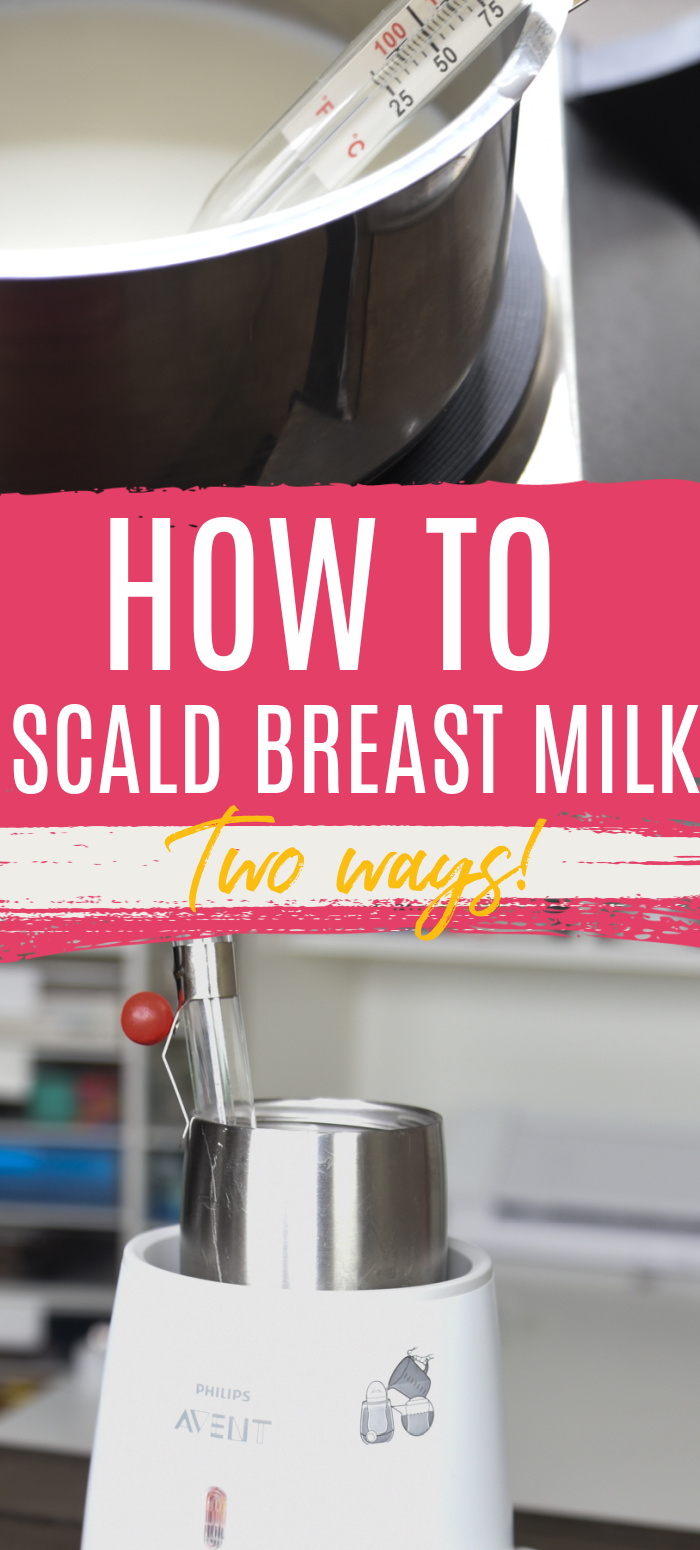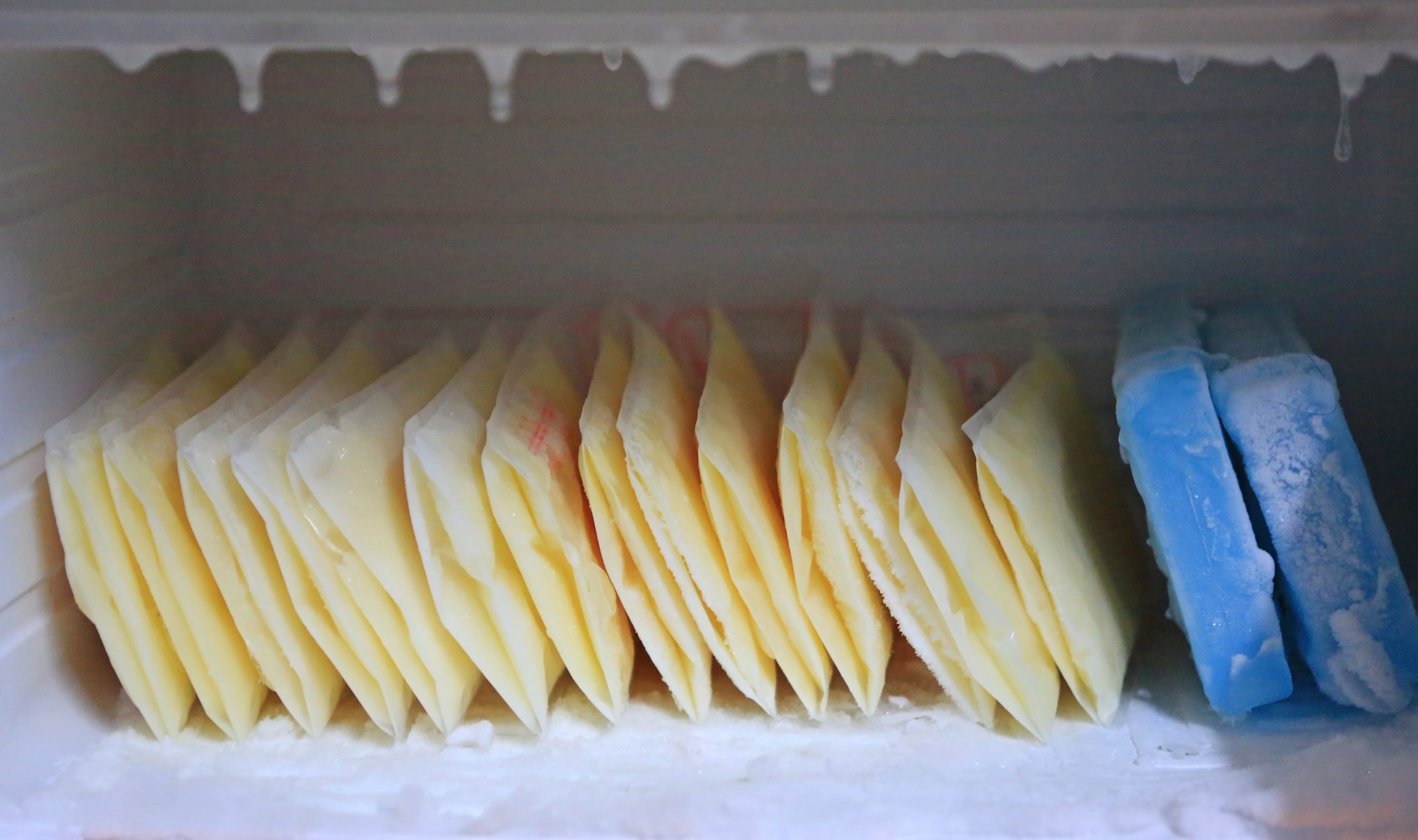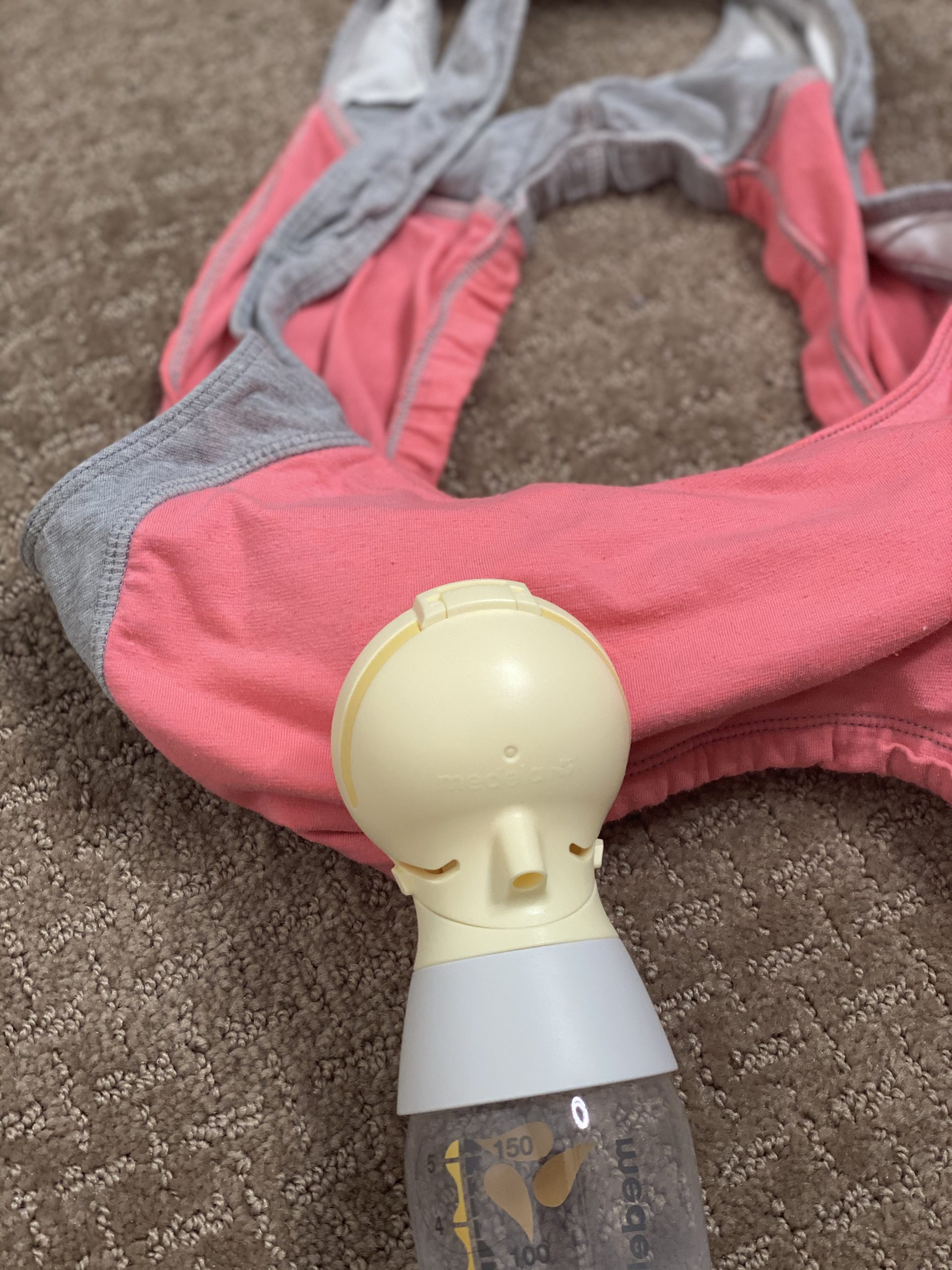Nipple shields can be a helpful tool to prolong the breastfeeding relationship – but when it comes to wean, they sure can be a pain! Here are nine tips to help you successfully wean your baby from a nipple shield!
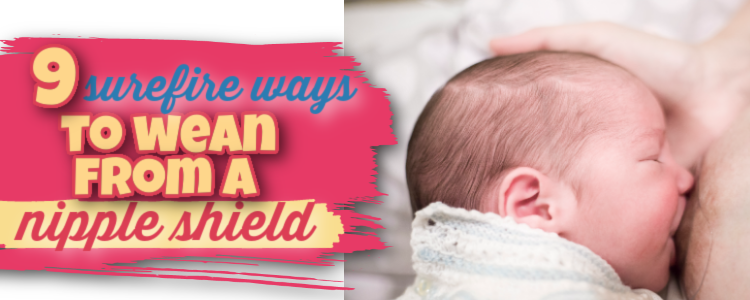
Not a week goes by that I don’t have a mother contact me about weaning from a nipple shield.
Nipple shields have their benefits, but they can also be a pain – especially when you want to wean from it. Often, moms are given a nipple shield and no further instruction – including advice on how to wean from it.
Your baby can get acquainted with breastfeeding with a nipple shield and might become reluctant or incapable of feeding without it. Here are some techniques you can use to encourage your baby to wean off the nipple shield and take the breast.
- Do I Have to Wean from a Nipple Shield?
- Tip #1: Determine the Problem
- Tip #2: Be Patient and Keep it Positive
- Tip #3: Skin-To-Skin Contact
- Tip # 4: Suck-Training
- Tip #4: Watch for Early Hunger Cues
- Tip # 5: Breastfeed Frequently
- Tip # 6: Boost Your Let-Down
- Tip #7: Give a Reward
- Tip #8: Switch Part Way Through
- Tip #9: Try, Try Again
- More Posts You May Enjoy:
Do I Have to Wean from a Nipple Shield?
I get this question pretty frequently. And the answer is – no, there is no rule that says you must stop using a nipple shield by x amount of weeks or months.
Nipple shields are designed for short-term use, but there are moms who use them the entire time their nursing for one reason or another. If you find that you like using a nipple shield, your baby is growing and thriving, and you feel more comfortable using the nipple shield – you don’t have to wean from it. You do you!
However, if you find that you hate the shield, it’s making you want to quit nursing, or you find that it’s interrupting breastfeeding more than helping – I would consider weaning. Most babies can wean from them successfully and transition to typical nursing.
If you are looking to wean, make sure you check out the nipple shield weaning kits from Back-to-Mom. They are fantastic! You can get 10% off with the code TBM10.
Tip #1: Determine the Problem
The first step to stopping the shield is determining the reason why a nipple shield was required in the first place.
Sometimes there wasn’t a problem, and if that’s the case, you can just skip to the next steps. But if there was an underlying cause, you will want to come up with a plan to fix that issue so nursing without a shield.
Here are some of the common reasons someone might be using a nipple shield?
- Premature Infant
- Small Mouth
- Engorgement
- Pain
- Flat Nipples
- Inverted Nipples
- Tongue Tie
Working with a lactation consultant can be a great step for solving some of the issues above. It should be noted that the above issues do not automatically mean you have to use a shield – but they are some of the most common reasons I see for someone using one.
Tip #2: Be Patient and Keep it Positive
The process to wean from a nipple shield can be emotional and difficult for all involved. While some babies will stop using one without issue, it doesn’t always go that way.
It’s important to be patient with yourself and with your baby. Try and stop using it during a nursing session that’s going well, when baby isn’t overly hungry, and when neither of you are tired. And if it doesn’t go well? Stop and try again later. The last thing you want is for either of you to have an aversion to nursing because you get so frustrated while doing it.
When your baby does nurse without a shield – even if it’s just for a few seconds – gives lots of praise. Babies pick up on that sort of thing and positive reinforcement is important.
Rome wasn’t built in a day and chances are, it’s going to take time to wean from that shield. It WILL get better with time if you have the patience to get to that point – and I know you can 🙂 Positive affirmations and intensions can help!
Tip #3: Skin-To-Skin Contact
Trust in the power of skin-to-skin. Do as much skin-to-skin as possible, even when the child isn’t feeding. This serves to re-wire an infant’s mind and can help them latch without the shield. Skin-to-skin can have a BIG effect in getting a child to latch.
Specialists believe babies have natural breastfeeding reflexes that are stirred when the infant is put inclined and skin-to-skin with the mother. So, take advantage of what a child’s body is programmed to do. Wrap him up in a sling “kangaroo style,” or you can even take a stab at nursing in the bathtub. When the baby begins rooting, slide him down so his head is level with your breast and permits him to self-latch.
Tip # 4: Suck-Training
With the nipple shield, she may push her tongue to the top of her mouth to reduce milk flow. So, teach your baby the opposite of this. Offer your baby your index or pinkie fingernail-side down to suck on for a few minutes prior to feeding. This suck-training instructs him to drop his tongue down as she should do with breastfeeding.
Here is a great article on suck training that might be helpful.
Tip #4: Watch for Early Hunger Cues
I would say that the worst time to try and take away a nipple shield is when your baby is super hungry. They probably won’t have the patience of the change. So when you are wanting to wean from the nipple shield, try and be strategic with the times you try.
Watch for those early hunger cues and offer the breast at that point. Your baby may feel more inclined to try something new if they aren’t desperately trying to get milk.
Tip # 5: Breastfeed Frequently
I’m all about “on-demand” feeding, and that can be really helpful when trying to wean from the nipple shield. Looking for your infant’s appetite cues instead of watching the clock will help you know when she is ready to feed and keeps the child from getting over-hungry and fussy. Crying is a late indication of hunger, and it is hard to latch a crying, frustrated baby. Watch for signs, for example:
- sucking on fingers,
- rooting,
- making smacking noises with her mouth.
Even if the baby has just breastfed, it is OK to nurse the baby again. Frequent nursing helps the baby practice nursing, and it offers more opportunities for the baby to try nursing without the shield.
Tip # 6: Boost Your Let-Down
Prior to trying to breastfeed the baby, pump to a letdown or, for an even more convenient option, you can hand express to a letdown. This will evoke a let-down and lengthen the nipple for the baby.
Along these lines, your child gets a quick compensation for latching on. When the milk begins streaming, bring your child to the breast. Sometimes this is just enough temptation to get the infant to open wide and latch. Consider using breast compression if your baby starts to nurse, so she gets a burst of milk, urging her to continue onward.
Tip #7: Give a Reward
Sometimes hand expressing a little bit of milk onto your nipple and areola before latching can entice the baby just long enough to convince them that maybe nursing without a shield isn’t so bad!
Tip #8: Switch Part Way Through
You can try and slowly remove the shield once your baby has started nursing and is actively nursing. They may not love this at first and protest, but it can be very effective. I would only remove the shield once a letdown has started and milk is coming out.
Tip #9: Try, Try Again
I’ve echoed this throughout this post but try not to get discouraged and just keep trying. I find that it usually takes a good three days to change a habit for a baby, and that can be very true with a nipple shield. The more opportunities you give for the baby to nurse without the shield, the better. Keep it positive and just keep trying!
More Posts You May Enjoy:
- High Lipase Breast Milk: Why Your Breast Milk Tastes Gross (and What You Can Do)
- How Much Breast Milk in a Bottle – Baby Milk Intake Calculator
- Top Signs of Low Milk Supply to Worry About
- 22 Low Milk Supply Causes You May Not Know About
- 5 Must-Know Clogged Milk Duct Symptoms
